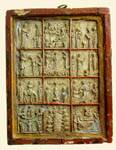|
|
| Byzantine Minor Arts |
14th c. Vatopedi Monastery Steatite 23 x 16.5 cm |
|

|
This icon, which is in relatively good condition, is divided into twelve panels (four rows of three) separated by a delicate, corded edging. These panels contain representations of the Dodekaorton, each identified by an incised inscription: Annunciation, Nativity, Presentation in the Temple, Baptism, Transfiguration, Raising of Lazarus, Entry into Jerusalem, Anastasis, Ascension, Pentecost, Koimesis. Iconographically, the compositions are simplified, but this simplification, which does not follow the same pattern in each scene, is evidently a result of the artist's own concerns rather than the influence of some specific model. Thus, while constraints of space have obliged the artist to retain only the principal figures in each scene, the adjustments of scale are not an indication of their relative importance but an unsuccessful attempt to differentiate between planes and to create a sense of third dimension. In the scenes of the Nativity and the Transfiguration, for example, the figures in the foreground are rendered in a smaller scale than those in the background, while in those of the Baptism and the Entry into Jerusalem the figure of Christ is on a smaller scale than those around him. The relief, lower than is usual for the fourteenth century, does not leave much margin for plasticity in the modelling of either the figures or the drapery. In spite of this, however, and although the figures are in general somewhat stylized, it is evident that particular care has been taken with the principal figures, and especially in the rendering of their facial features. The subject of this icon, held to have been a gift from relatives of John VI Cantacuzenos from Ioannina in the fourteenth century, is a favourite for enkolpia: the Vatopedi Monastery has another three with the same subject and the Dionysiou Monastery one; they can be dated in the twelfth and fifteenth centuries (Loverdou-Tsigarida 1996, p. 460). While the iconography of these works may have derived from earlier examples, such as the twelfth-century steatite icon in the Treasury of the Cathedral of Toledo (Kalavrezou-Maxeiner 1985, pp. 143-50), as principal models are thought to have served painted works, such as portable icons. It should further be observed that, while these steatite icons were in fact mass produced, a fair number of different models must have been used (Kalavrezou-Maxeiner 1985, p. 61).
| |
|
Bibliography: Kalavrezou-Maxeiner 1985, pp. 217-8 (with earlier bibliography). Loverdou-Tsigarida 1996, p. 460, fig. 393.
| ||
| K. L-T. | ||
| Index of exhibits of Monastery of Vatopedi 14th century |
||
Reference address : https://www.elpenor.org/athos/en/e218ci4.asp